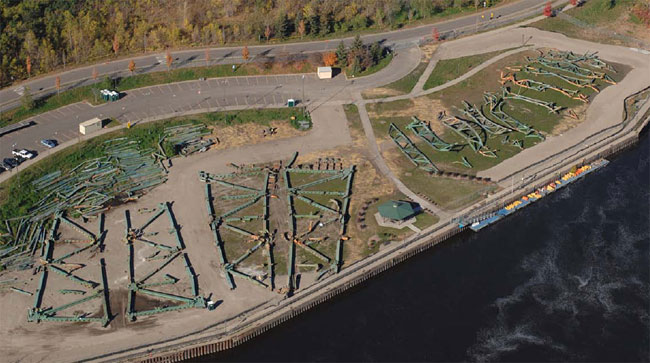Over the years, the area in the foreground went from being residential to industrial, many tons of coal was stored there to supply local power production and salt was piled for spreading on the roads in the winter. Somewhat acclaimed poet John Berryman jumped off the bridge on this very spot on January 7, 1972, landing on the concrete of the docks to fatal effect.
The same view in 1902, when thousands of immigrants lived along the river.
A view from the upriver side of the bridge. These areas were used to store the detritus of the 35W bridge collapse in 2007 while attorneys argued over who would make the payments to the survivors of the 13 dead and the 145 people injured in the event. The property's value as a recovered natural riverbank setting was less than that of a storage area for junk structural steel.

The powers that be were never happy with the "Bohemian Flats" and as years went by its susceptibility to flooding, antiquated housing and disputed ownership, followed by its increasing commercial irrelevance and unattractive appearance, led it to be acquired as part of the Minneapolis park system.
Oddly, instead of a vibrant "ecosystem" that included many varieties of humans, the flats area is now merely a public lawn. The color "green" is associated, falsely, with nature. There are "green " political parties devoted to environmental causes. "Green" is a frequently used adjective by those pontificating on environmental issues. Yet, the color, in itself, really has no relationship to the totality of nature, being only the hue of chlorophyll. The lawns that have been installed are as unnatural as linoleum or carpeting. No bank of the Mississippi anywhere ever looked like this before it was put to use. Never easily accessible from the rest of the city, even now few people are tempted to spend any time in this green, urban desert.
The sterile, vacant aspect of the urban section of the upper Mississippi contrasts sharply with that of some other rivers in the world, which remain vital parts of the cities that adjoin them.

For instance, the Mekong River in Southeast Asia is itself literally the home for thousands.
As time has gone by, public entities have acquired much of the upper Mississippi's banks and turned them into supposedly recreational property. When the last piece has been taken, what occurs next? Will the authorities and the taxpayers demand that areas perhaps a quarter mile from the river be included in its preservation? What is the end point of this process?



1 comment:
+1
Post a Comment